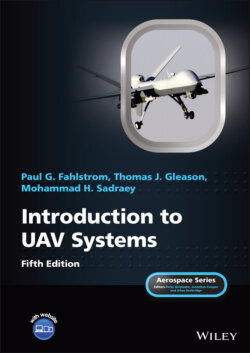Читать книгу Introduction to UAV Systems - Mohammad H. Sadraey - Страница 77
3.10 Friction Drag
ОглавлениеThe friction drag mainly includes all types of drag that do not depend on production of the lift. Every aerodynamic component of aircraft (i.e., the components that are in direct contact with flow) generates friction drag. Typical components are the wing, horizontal tail, vertical tail, fuselage, landing gear, antenna, engine nacelle, camera, and strut. The zero‐lift drag is primarily a function of the external shape of the components.
Since the performance analysis is based on aircraft drag, the accuracy of aircraft performance analysis relies heavily on the calculation accuracy of friction drag (i.e., CDo). The CDo of an aircraft is simply the summation of CDo of all contributing components:
(3.13)
where CDof, CDow, CDoht, CDovt, CDoLG, CDoN, CDoS, and CDoP are respectively representing fuselage, wing, horizontal tail, vertical tail, landing gear, nacelle, strut, and external payload contributions in aircraft CDo. The three dots at the end of Equation (3.13) illustrate that there are other components that are not shown here. They include non‐significant components such as the antenna and pitot tube. In the majority of fixed‐wing conventional air vehicles, wing and fuselage each contribute about 30%‐40% (a total of about 60%–80%) to aircraft CDo.
Reference [12] provides a build‐up technique to calculate the contribution of each component to CDo of an aircraft. The majority of the equations are based on flight test data and wind tunnel test experiments, so the technique is mainly relying on empirical formulas.
